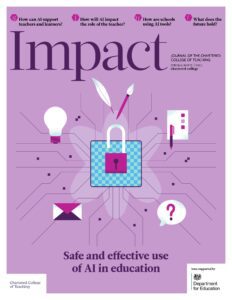Augmenting instruction with artificial intelligence in geography lessons

GEORGE DAVIES-CRAINE, LANCASTER GIRLS’ GRAMMAR SCHOOL, UK
This paper presents practitioner research on augmenting instruction with artificial intelligence (AI) in the geography classroom, which was presented at the International Coalition of Girls’ Schools symposium in 2024 (ICGS, 2024). The purpose of this research was to understand how AI can be used to improve student learning in geography. AI can support learning by improving self-efficacy, leading to the empowerment of girls and engagement within the classroom space (Navan, 2008). Students need to be taught how to use AI, rather than present the output of AI as perceived understanding (Luckin et al. 2022; Perotta and Selwyn, 2020).
The research question was: to what extent does AI improve learning in geography? Over the course of one term, 24 Year 8 students and six Year 12 students were involved in the study. An action research methodology was used as it enabled a variety of data collection methods and reflection on the strategies used within the classroom (Mertler, 2016).
The action
The action was teaching students how to use generative AI (GenAI) lessons to consolidate their learning, focusing on prompt engineering. The GenAI tool used was Copilot, as the school uses Microsoft. Firstly, students were presented with ‘laws’ of AI use, put together by the author, which are illustrated in figure 1. Secondly, the difference between active and passive prompts was explained to the students; an active prompt elicits an interactive output, such as a multiple-choice quiz or spot the mistake, and a passive prompt elicits an informative output. Finally, students were shown examples of prompts and told that as well as following the laws of AI use, effective prompts should contain an explanation of the task AI is required to undertake, information that will make the output as specific as possible, and the format the response should take (see figure 1).
Students used this structure to help them consolidate their understanding of topics learnt in the classroom. They used active prompts to create multiple choice quizzes to self-test their knowledge of material (see figure 1). Some students completed this as a homework task, whilst others did it in class.
Augmenting instruction with AILaws of AIStudents were presented with the following ‘laws of AI use’:
Active and passive promptsThe difference between active and passive prompts was explained to the students:
Prompt engineeringExample prompts were presented to and explained to the students. Students were able to alter these prompts to include other interactions with AI, such as ‘critically compare two opinions’, or ‘if this is the question what is the answer?’, and ‘which is the odd one out and why?’. Example active prompts
Example passive prompts
Points to consider when prompt engineering
|
Figure 1. Augmenting instruction with AI
Data collection and findings
Data was collected using a mixed methods approach: questionnaires were given to students before and after the action, and focus groups were conducted during the action. Knowledge quizzes were given to students a week after using AI to gauge their understanding. Three themes were drawn out from the data. Using AI tools helped improve learning by:
- creating more effective learners: students gained a greater understanding of the material being learnt and engagement was increased.
- developing agency during the learning process: students became more independent and creative learners.
- building confidence: students became more digitally fluent.
Discussion and implications for pedagogy
Results from the questionnaire and focus groups showed an increase in students feeling that they learnt more effectively in geography when using AI; this was echoed in the knowledge quizzes. While this is not a perfect measure, 26 out of 30 students surveyed stated that they used AI to help them understand more difficult concepts, and 25 out of 30 students felt that using AI made geography more engaging and interesting, the reasons for this primarily centered around doing something different, but more importantly, it can help deepen their understanding of the topic at hand, because it can give a clear answer, but they were aware of being critical of the output. However, a minority of students felt the AI outputs were too formal and difficult to understand, which is an issue with AI. The prompt must state the year group so that the AI output is tailored to the audience, showing the importance of carefully crafted prompts. Three quarters of students surveyed stated that AI helped them become more independent learners and as a result became more creative with using AI, prompting it for personalised feedback on work they had completed at home, before gaining teacher input. The use of AI also developed confidence through increasing digital fluency. The term ‘digital fluency’ goes beyond just Googling an answer (Gilbert, 2014), it is a kind of poesis, with students using AI to gain a deeper understanding of a concept. Students can interact with AI tools through creation of an effective prompt, refining the output through further prompts and in some cases have a debate with AI on an academic topic.
The implications of using GenAI in this way are wide ranging, from providing some form of personal feedback to furthering their understanding of more complex concepts, before the next lesson. This allowed students to access tailored instructions for their work to further their understanding. When AI was used in the lesson, it can create a broader learning environment, however students did recognise the flaws of AI use. This goes back to the original point that students need to be taught, in the long term, how to use it effectively.
The examples of AI use and specific tools in this article are for context only. They do not imply endorsement or recommendation of any particular tool or approach by the Department for EducationThe ministerial department responsible for children’s services and education in England or the Chartered College of Teaching and any views stated are those of the individual. Any use of AI also needs to be carefully planned, and what is appropriate in one setting may not be elsewhere. You should always follow the DfE’s Generative AI In Education policy position and product safety expectations in addition to aligning any AI use with the DfE’s latest Keeping Children Safe in Education guidance. You can also find teacher and leader toolkits on gov.uk .
- Gilbert I (2014) Why do I need a teacher when I’ve got Google? The essential guide to the big issues for every 21st century teacher. Abingdon: Routledge.
- ICGS: International Coalition of Girls’ Schools (2024) Celebrating the power of girls and girls’ school. Available at: https://girlsschools.org/8-november-2024-educating-girls-symposium-at-wimbledon-high-school/breakout-sessions-educating-girls-symposium-at-wimbledon-high-school-gdst/ (accessed May 2025)
- Luckin R, George K and Cukurova M (2022) AI for school teachers. London: CRC Press.
- Mertler C (2016) Action research: improving schools and empowering educators. 5th edn. London: Sage.
- Navan J (2008) Nurturing the gifted female. London: Corwin.
- Perrotta C and Selwyn N (2020) Deep learning goes to school: Toward a relational understanding of AI in education. Learning, Media and Technology. 45(3): 251–269.










